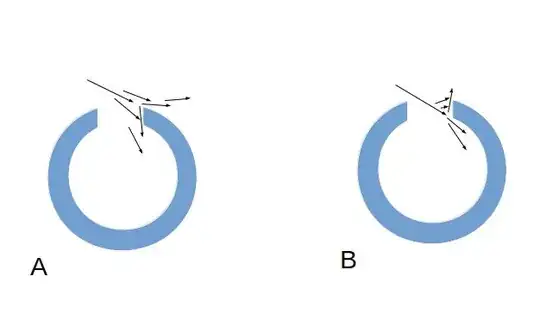Since it's about a technical issue, I thought that this question would fit in here the best (as opposed to the music.stackexchange-site): I'd like to know how tone-production in an irish (wooden) flute takes place: Namely, I'd like to know where exactly the stream of air is split and begins oscillating. To illustrate what I mean, I've drawn two little figures (A and B), and I'd like to know which of them is right.
Edit (because the figures seemed to be confusing): In both figures we see a stream of air directed on either of the two edges in the barrel of a flute mouthpiece, and respectively two streams of air flowing away from the edge, one to the insides of the flute, one to the outside. If an edge-tone develops, the air will (in either of the 2 figures) oscillate between the stream going inward the flute, and the stream going outward.
I always thought the air is split by the upper edge (as it is indicated in figure A). This does as well make sense to me because this edge is mutch more capable of splitting the stream of air.
However, a irish flute player I know suggested to me that instead it is the lower edge in the barrel of the flute where the stream of air is split. At first this seemed odd to me (because the edge is mutch less capable of actually splitting the stream of air there, which is required to generate oscillating air movements). However, this would explain why, when playing irish flute, many flute players suggest to blow "down the whole", instead of blowing on the edge.

So the question goes out to the community: Which figure is right, A or B? I'd be happy if you could provide a source of your knowledge, preferably somebody who either has worked with irish flutes a lot, builds them, or did observe the illustrated air-flows inside.
I'd be also happy if the answers stick to wooden (irish) flutes, as there might be a difference to silver-flutes.
Edit: I'm well aware that the phenomenon of tone production of wind being parted at an edge is called "edge-tone", and that this in fact is the source of the sound in irish flutes. The purpose of this question is, however, to find out where exactly this edge-tone is formed.